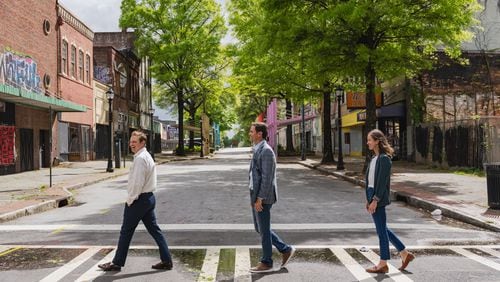Third in a three-part series
A new tactic in state water policy has big implications for proposed reservoirs around the metro area, benefiting some while leaving others to fend for themselves.
The new policy focuses on reservoirs not just as sources of drinking water, but as regional projects to improve downstream flow and water quality for essential rivers such as the Chattahoochee.
“We are in the middle of a significant water policy shift for the state,” said Jud Turner, director of the Environmental Protection Division of the Georgia Department of Natural Resources.
The shift gives a boost to struggling projects that can be used this way, such as the proposed Glades Reservoir in Hall County or Indian Springs in Carroll County. For other projects that cannot serve this dual purpose, this strategy means they will get less help, despite millions of dollars that local ratepayers have already invested.
The policy shift is something of a reality check.
All the half-dozen reservoirs proposed around the greater metro area have relied for years on state projections that predicted a massive boom in population. City and county officials cheered when Gov. Nathan Deal backed their dreams with a pledge of $300 million in low-cost loans and direct investment to make long-sought reservoirs a reality.
But new projections released by the state earlier this year show post-Great Recession growth at a fraction of what had been predicted. That’s a hard pill to swallow for locals who have already spent millions buying land and hiring consultants.
The new growth projections make the state’s chain of proposed reservoirs harder to justify purely for drinking water. The water just isn’t needed.
Rather than equally supporting all the planned projects, Turner said turning some of the projects into regional reservoirs makes the most sense for the state.
“To me, this is the right way to do this,” he said. “We need a few deployed multipurpose reservoirs in the region.”
To get them done, the state is willing to help pay for them by directly investing in select projects. Richland Creek Reservoir in Paulding County is an example, he said.
Last month, officials in Paulding received their federal permit for the planned reservoir. The state has put $15.2 million in direct investment and nearly $60 million in low-interest loans into the Paulding plan.
Paulding County currently buys its water from Marietta, which uses Lake Allatoona as its source. Alabama depends on water from that same watershed and already has accused Georgia of taking more than its share.
Turner said the state’s interest in Richland Creek is to ease direct demands on Allatoona. By providing Paulding with its own source of water, Marietta and Cobb County get some relief and room to grow.
“This is where we are headed in the program,” he said.
That’s good news for other favored projects such as Glades Reservoir and perhaps Indian Creek. But not for other reservoirs with less “regional” appeal.
South Fulton’s struggles
The small south Fulton County cities of Fairburn, Palmetto and Union City have been working on the proposed Bear Creek Reservoir for more than a decade. But in September, city leaders withdrew their permit request from the U.S. Army Corps of Engineers.
“This by no means kills the project,” Palmetto Mayor Clark Boddie said. The three partner cities decided to pull the reservoir permit when it was clear they were not going to meet deadlines imposed by the corps for certain parts of the plan, Boddie said.
Corps spokesman Billy Birdwell said the cities need to provide additional information about, among other things, the need for the reservoir in light of “greatly decreased population projections.” Once that information is provided, the cities can reopen their application, he said.
Juliette Cohen, the executive director of the environmental group Chattahoochee Riverkeeper, said the move to withdraw the application is not a great surprise.
“For years, the corps has been going back and forth with (the cities), asking for more information,” she said. “We had been getting signs it is on life support.”
Keeping it going has been costly. In 2013, the three cities received $10.5 million in loans from the governor’s water fund to add to more than $41 million in local bond debt.
The project appears to face long odds, but Boddie is upbeat. He believes Fulton County’s growth pattern supports the case for the reservoir.
“I don’t see any big obstacles once we do the work that we need to do to resubmit (the application),” he said. He predicted the project would get its needed permits by mid-2016.
Turner is not convinced. The EPD has to issue a certification of need for reservoir projects, and Turner said he will need more evidence that the three cities in one of the more depressed regions of the metro area are going to see a population boom.
“You can give me a Fulton growth number and that doesn’t tell me about south Fulton,” he said.
State looks to partner on Glades
For other projects, especially the proposed Glades Reservoir in Hall County, lower population projections aren’t as big an issue with the state if the locals agree to think beyond the county line.
The planned reservoir in the governor’s home county has been on the books for years and has already gone through a variety of incarnations as local politicians have planned and spent millions on experts in an attempt to get the needed permits.
“In Glades’ case we think the project should absolutely go forward,” Turner said. Operated as a regional water resource, Glades could be used to pump water into the Chattahoochee during times of lower flow, refreshing the water system all the way to the oyster beds of Apalachicola, Fla.
But, he said, if Hall County wants to continue the project solely to provide drinking water, “need is going to be an issue.”
“We’re going to have to have a conversation about that with the locals,” he said. “We have long known and long believed that we were going to have to pivot on this project. … The locals may say: ‘We don’t want to pivot. We own the land.’ ”
Conservationists who view reservoirs as a wasteful and costly approach to water policy are frustrated by the evolving arguments that keep projects such as Glades in the mix. Laura Hartt, the water policy director for Chattahoochee Riverkeeper, said politicians are pushing the reservoirs regardless of whether they are needed.
“It seems to me the reservoir program had this end goal and they have been doing all kind of maneuvering to get to that end goal even though the facts changed,” she said. “It’s not rational decision making to just ignore the world because you want a reservoir.”
Hall County is home to about 187,000 people. Earlier population projections predicted that number would swell to 730,000 by 2050. Glades was proposed to meet that water demand, but new, post-Great Recession projections released earlier this year set the county's midcentury population at just 318,828.
A similar situation in Newton County caused officials there to shelve their planned reservoir after spending 15 years and $20 million trying to get it permitted when they decided slower growth made the project unsustainable.
Richard Mecum, the chairman of the Hall County Board of Commissioners, said he welcomes state participation in Glades, although he does not buy into the new population projections.
The state has yet to put any money into Glades, but Mecum said there already have been talks about operating Glades as a regional reservoir. But in order to serve downstream needs, the state would have to have some say in how Glades was designed and operated.
“I don’t want to say anything about that yet,” Mecum said. “That’s going to be part of the discussion.”
When asked whether the pivot in reservoir policy was made with an eye toward the ongoing tri-state settlement talks, Turner steered away from the politically and legally touchy subject.
However, he did describe the policy as a win for downstreamers, including in-state communities such as Columbus that have viewed upstream reservoirs as a threat to their own growth.
“We’re not doing it for settlement talks or anything,” he said. “It’s just the right way to run a railroad.”
About the Author




/cloudfront-us-east-1.images.arcpublishing.com/ajc/P7DYBH6TO7FEKG4SUXQQKADRXE.jpg)


